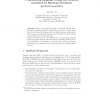421 search results - page 33 / 85 » Staged concurrent program analysis |
TRIER
2002
13 years 7 months ago
2002
It is known that interprocedural detection of copy constants and elimination of faint code in parallel programs are undecidable problems, if base statements are assumed to execute...
SAS
2007
Springer
14 years 1 months ago
2007
Springer
Abstract. Silicon chip design has passed a threshold whereby exponentially increasing transistor density (Moore’s Law) no longer translates into increased processing power for si...
APLAS
2010
ACM
13 years 5 months ago
2010
ACM
Live heap space analyses have so far been concerned with the standard sequential programming model. However, that model is not very well suited for embedded real-time systems, wher...
QSIC
2006
IEEE
14 years 1 months ago
2006
IEEE
Pervasive programs should be context-aware, which means that program functions should react according to changing environmental conditions. Slicing, as an important class of code ...
COORDINATION
2009
Springer
14 years 8 months ago
2009
Springer
A future is a well-known programming construct used to introduce concurrency to sequential programs. Computations annotated as futures are executed asynchronously and run concurren...

